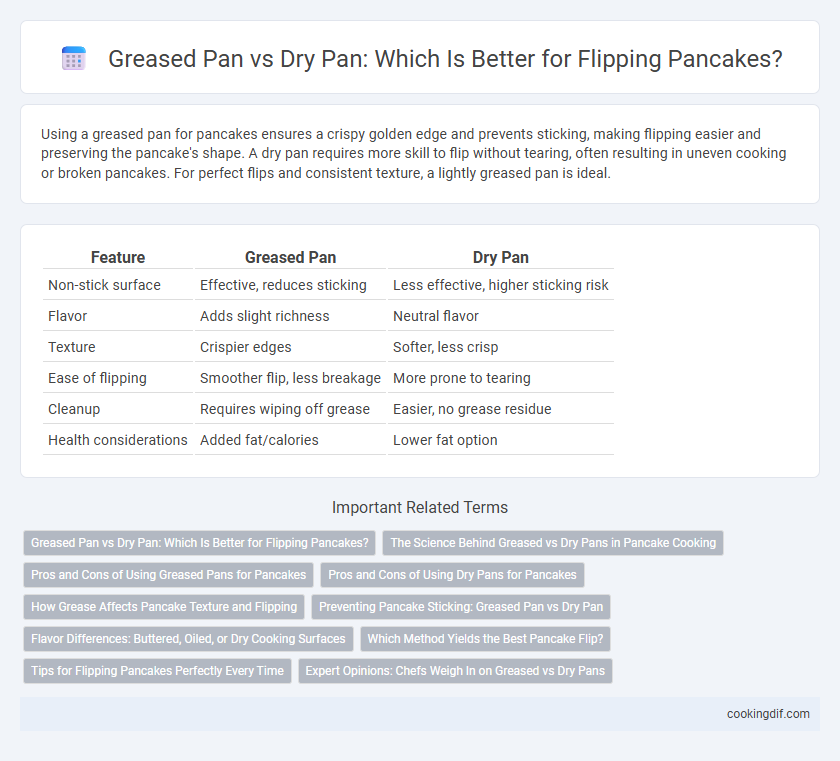Using a greased pan for pancakes ensures a crispy golden edge and prevents sticking, making flipping easier and preserving the pancake's shape. A dry pan requires more skill to flip without tearing, often resulting in uneven cooking or broken pancakes. For perfect flips and consistent texture, a lightly greased pan is ideal.
Table of Comparison
| Feature | Greased Pan | Dry Pan |
|---|---|---|
| Non-stick surface | Effective, reduces sticking | Less effective, higher sticking risk |
| Flavor | Adds slight richness | Neutral flavor |
| Texture | Crispier edges | Softer, less crisp |
| Ease of flipping | Smoother flip, less breakage | More prone to tearing |
| Cleanup | Requires wiping off grease | Easier, no grease residue |
| Health considerations | Added fat/calories | Lower fat option |
Greased Pan vs Dry Pan: Which Is Better for Flipping Pancakes?
Using a greased pan for flipping pancakes prevents sticking and promotes even browning, resulting in a tender, golden crust. Conversely, a dry pan requires a non-stick surface or higher heat control to avoid tearing and uneven cooking. Greased pans enhance texture and ease flipping, making them the preferred choice for flawless pancakes.
The Science Behind Greased vs Dry Pans in Pancake Cooking
Greasing a pan creates a thin oil barrier that prevents pancakes from sticking, allowing heat to distribute evenly and resulting in a golden, crispy exterior. Dry pans rely on natural non-stick properties or seasoning, which may cause uneven cooking and increase the risk of tearing during flipping. Heat conduction and surface tension differences between greased and dry pans significantly affect pancake texture and ease of flipping.
Pros and Cons of Using Greased Pans for Pancakes
Using a greased pan for pancakes ensures a non-stick surface, resulting in easy flipping and evenly browned pancakes, which enhances texture and flavor. However, excess grease can cause uneven cooking and soggy spots, affecting pancake quality and adding unnecessary calories. Balancing the amount of oil or butter is crucial to achieve the ideal crispness and prevent sticking without compromising taste or health.
Pros and Cons of Using Dry Pans for Pancakes
Using a dry pan for pancakes eliminates the need for added fats, resulting in a lower-calorie breakfast option while preserving the natural flavor of the batter. However, dry pans often increase the risk of pancakes sticking and tearing during flipping, which can affect presentation and texture. This method requires precise temperature control and non-stick cookware to minimize sticking and achieve evenly cooked pancakes.
How Grease Affects Pancake Texture and Flipping
Using a greased pan creates a slight barrier between the batter and the surface, promoting even browning and a crispy edge while preventing sticking during flipping. In contrast, a dry pan may cause pancakes to stick, leading to tearing and uneven cooking, which negatively impacts texture. Proper greasing ensures smooth flipping, maintaining the pancake's fluffiness and structural integrity.
Preventing Pancake Sticking: Greased Pan vs Dry Pan
Using a greased pan significantly reduces the risk of pancake sticking by creating a non-stick surface that facilitates easy flipping and even browning. In contrast, a dry pan increases the likelihood of pancakes adhering to the surface, causing tearing or uneven cooking. Optimal pancake results are achieved by applying a thin layer of butter or oil to the pan before cooking each batch.
Flavor Differences: Buttered, Oiled, or Dry Cooking Surfaces
Using a greased pan with butter imparts a rich, savory flavor and creates a golden, crispy exterior on pancakes, enhancing overall taste. Cooking on an oiled surface provides a neutral flavor while promoting even browning and preventing sticking. A dry pan produces lighter pancakes with a softer texture, but lacks the added flavor depth and crispiness from fats like butter or oil.
Which Method Yields the Best Pancake Flip?
Using a greased pan typically yields the best pancake flip due to reduced sticking and improved browning, allowing the pancake to release easily when flipped. A dry pan, especially a well-seasoned non-stick surface, can work but often requires precise heat control to prevent tearing or sticking. Optimal flipping results are achieved with a lightly greased skillet or griddle heated to medium, ensuring even cooking and smooth pancake release.
Tips for Flipping Pancakes Perfectly Every Time
Using a greased pan for flipping pancakes ensures a non-stick surface, preventing batter from sticking and creating even, golden-brown edges. A dry pan can cause pancakes to tear or stick, making flipping difficult and uneven. For perfect flips, heat the pan to medium-high, wait until bubbles form on the surface, and use a thin spatula to gently lift and turn the pancake in one smooth motion.
Expert Opinions: Chefs Weigh In on Greased vs Dry Pans
Chefs emphasize that using a greased pan creates a non-stick surface, allowing pancakes to flip easily without breaking, while a dry pan requires precise temperature control to prevent sticking. Professional cooks often recommend a light coating of butter or oil for even browning and a crisp edge, enhancing both texture and flavor. Expert consensus highlights that a properly greased pan yields consistently fluffy pancakes and reduces the risk of tearing or uneven cooking.
Greased pan vs dry pan for flipping Infographic

 cookingdif.com
cookingdif.com